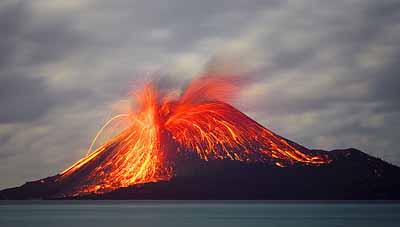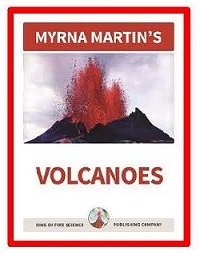What are Island Arcs?
Where Do island arcs Form?
Island arc formation
Island
arcs form on the crest of curved crustal ridges bounded on one side by deep
oceanic trenches. The trenches form as the subducting oceanic plate is bent
downward and plunges beneath the overriding plate.
Island arcs are volcanic islands that form parallel to ocean trenches in subduction zones. The Pacific Ring of Fire is home to many of these groups of islands. Volcanoes that form above hot spots like the Hawaiian islands are not volcanic arcs.

Volcanic island eruption USGS
Tectonic plates converge
Two oceanic plates converge
Islands form an arc when two oceanic plates converge creating a row of islands above the overriding plate. The older plate, which is heavier and denser, is forced beneath the lighter plate. The subducting plate begins to heat up as it descends into the lithosphere and eventually melts .
Formation of island arc
The leading edge of the oceanic plate begins to melt as it is forced deep into the crust and upper mantle. The melting plate feeds magma chambers that supply volcanic islands that form an arc when the molten rock erupts onto the ocean floor of the overriding plate.


Click for More Information and to Order
Mariana Islands trench
Mariana Islands
Deep ocean trenches form between the converging plates. Islands form parallel to the ocean trenches on the overriding plate. The Marianas trench, where the Challenger Deep is located, forms the boundary between two converging oceanic plates. The Mariana Islands are parallel to the trench and formed beside the trench.
Aleutian Islands
Aleutian Islands in the North Pacific Ocean
The Aleutian Islands are located
on the continental side of the Aleutian trench that separates the Pacific Plate
and the North American Plate in the North Pacific Ocean. They are an arc of
islands. The molten rock from the melting Pacific Plate feeds the Aleutian
Islands volcanoes.
Arc of Volcanoes
Arc of volcanoes on continents
Arcs of volcanoes form on land and not in the ocean. The arc forms due to the curvature of the Earth. Many of the volcanoes are either active or dormant.
Cascade Range in the Pacific Northwest
The Cascade Range is an arc of volcanoes in the Pacific Northwest. The volcanoes formed on the continental side of the Cascadia Subduction Zone. Mount Hood, Mount Rainier, Mount Saint Helens, and Mount Shasta are examples of an arc of volcanoes on land in a subduction zone
Active, Dormant, and Extinct volcanoes
Active volcanoes
Active volcanoes are volcanoes that have erupted within the last 10,000 years after the last ice
age ended. (This is the definition used by the Global Volcanism Program in
their catalogs.)
Dormant volcanoes
Dormant volcanoes have not erupted in the past 10,000 years but scientists expect they will erupt
again. Composite volcanoes (stratovolcanoes) often have long periods between
eruptions.
Extinct volcanoes
Extinct volcanoes are not expected to erupt again. Pinatubo was listed as an extinct volcano before it
erupted in 1991. The Pinatubo eruption was the 2nd largest eruption
of the 20th Century. The last previous eruption by Pinatubo was in the 1500s. Stratovolcanoes are sometimes dormant for thousands of years between eruptions.
KIDS FUN Science Bookstore
Check out Myrna Martin's award winning textbooks, e-books, videos and rock sets. The Kids Fun Science Bookstore covers a wide range of earth science topics. Click here to browse.










